Executive Roundtable: Where is Your Physician?
A panel of biopharma executives discuss market access and the changing dynamics in reaching physicians and healthcare professionals.
In an executive roundtable discussion, underwritten by Zephyr Health, a panel of biopharma executives share their insights on market access and the changing dynamics in reaching physicians and healthcare professionals.
The challenge for market access professionals is trying to put the payer, patient, provider, and health system together in a way where they all benefit. Given the complexities of healthcare delivery, which is fragmented, and the increasing costs to patients to purchase their needed medicines, market access executives have a near impossible task. This executive roundtable was underwritten by Zephyr Health and uncovered many themes during the collegial discussion. These issues included physician access and education, patient access, the changing role of the pharmaceutical sales representative, and the role of technology.
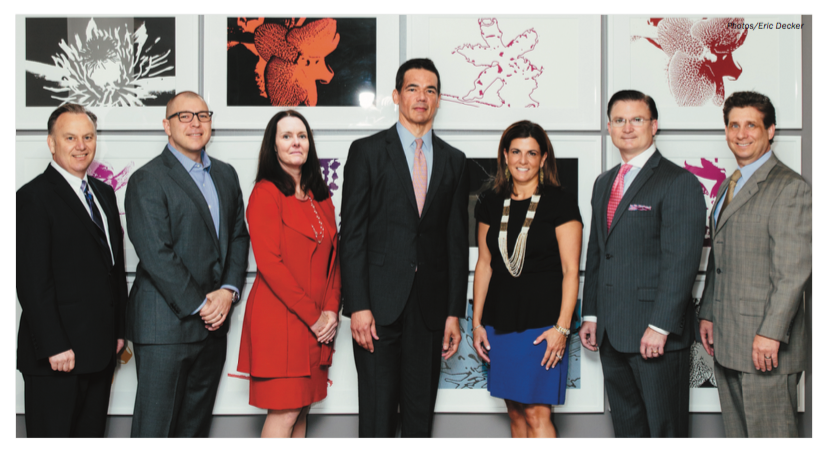
Photos: Eric Decker
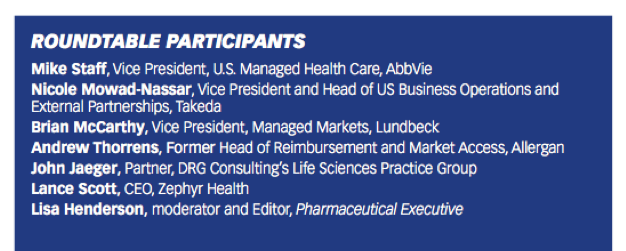
PE: What are the challenges to current market access, as it relates to the physician, and your sales representatives reaching those physicians?
BRIAN McCARTHY: Access to physicians, with the consolidation occurring in systems as well as physician practices, the reps are getting squeezed out. They have less opportunity to communicate the value proposition of our medicines. And this is happening at the same time the value proposition has become more complex.
But there is opportunity for pharmaceutical companies to improve how we communicate with physicians. Maybe through electronic health records or e-prescribing, but there is an undercurrent of communication that’s taking place that physicians and other decision-makers tap into. So we can get into the communication streams of where physicians, payers and others are consuming information.
JOHN JAEGER: To your point, the massive consolidation is changing the dynamics around centralized decision-making. For some regions, there is a large amount of depth and breadth. Think about how heavily penetrated Cleveland Clinic might be in the Cleveland area. Your sales team could be having hundreds of interactions with that system in a given day, but the level of influence that those individuals are having could be very different. Not all visits and interactions and engagement activities are going to be created equal when you have a much more centralized decision-making structure.
McCARTHY: Exactly. That autonomous decision-making of the physician is becoming less and less. We
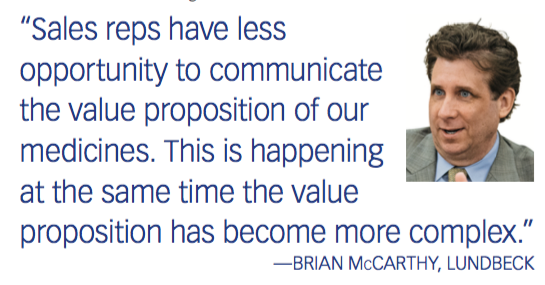
need to move representatives to account managers. Because even at a “rep level,” they’re dealing with physicians who are part of systems or groups. The reps need to approach that as an account, not solely from a physician-to-physician-to-physician approach.
MIKE STAFF: That’s part of the evolution that we’ve had at AbbVie. But the Cleveland Clinic example is a great one. We recognized about four years ago that there was a consolidation of decision-making at these large health systems. At the same time, the electronic medical record became mandated by ACA. Those events made us start focusing on a relationship with the health systems, not from a promotional perspective but from a business-to-business perspective.
We created health system executives that would dig into their needs and goals, as opposed to a product approach. It’s going from a standard-of-care approach to a population health approach. We moved the conversation to, “How do you get more patients diagnosed and ultimately treated?” It’s good for the patient, it’s good for the system and it’s good for lowering the overall cost of healthcare.
NICOLE MOWAD-NASSAR: At Takeda, we too are shifting our approach. We have focused a lot on partnering for access as a priority, and we’ve been trying to increase our capabilities to do that.
Like AbbVie, we have focused on upscaling our account executives so they’re partnering with the healthcare systems but also forging much closer collaborations with our medical affairs associates. So now managed markets and medical are more hand-in-hand than they’ve ever been before.
It’s very important for evidence generation to partner with payers and work within their own system, using their data and addressing obstacles to infrastructure and data analysis. This partnership is necessary to demonstrate real-world evidence in the environment.
ANDREW THORRENS: Which is great because, in doing so, you’ve now aligned some of the commercial elements with health economics. I see this as a big win for patients and hold out hope that earlier communications between manufacturers and payers may lead to earlier coverage determinations, which, in turn, may improve patient access.
JAEGER: There are tools and resources that can help us take the traditional view we’ve had of the sales representative role, or the commercial team role, and really help evolve that so it’s much more in sync with
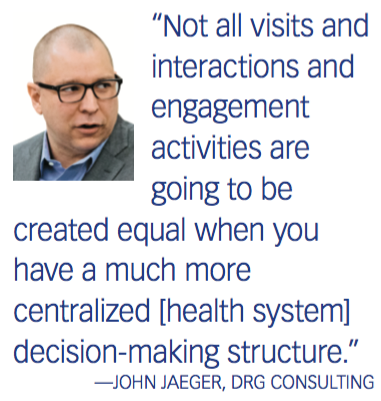
what’s critical to the other stakeholders within the healthcare value chain.
LANCE SCOTT: We released a survey that we did with about 60 leaders across 22 pharmaceutical companies in different roles-market access, sales and marketing leadership. Almost 70% said they’re all using some type of market access data on a regular basis. However, 40% said there are still opportunities and gaps in terms of better using that data to align the functions and the go-to-market approach across those functions within any given healthcare company.
MOWAD-NASSAR: In terms of the technology perspective, what is very exciting is the data density that’s generated from smartphone devices and other connected devices, and the data from the EHR systems, that’s allowing us to drive insights on patients that would have taken us years to uncover before platforms-frankly, like Zephyr’s-that allow you to derive insights from algorithms and machine learning.
Takeda has recently engaged Zephyr to take our data and make it more patient-insight driven so that the representatives have information that can bring higher utility to their discussions.
We’ve been really encouraged by the data aggregation and insights we’ve been able to produce.
THORRENS: You can have a portal that provides sales representatives with a lot of analytics. My prior experiences with rep portals, however, has been varied. Some reps love to mine the data unique to their customers. But many reps don’t really use the portal at all. To them, the portal is just another CRM platform that’s devoid of real-world experience. They think, “I know my physicians; I have my relationships and know what’s going on in their practice.” In my opinion, this is part of the struggle in the evolution to create this new kind of specialized business that relies on analytics.
SCOTT: One thing we’re doing is based exactly on the rep struggle you described.
Some representatives have a large number of targets or accounts with a lot of data that’s changing constantly. We are taking a more consumer-driven approach, serving up information to the field team-be it account managers or representatives-at a time when it could be more useful to them and based on change in that data or information.
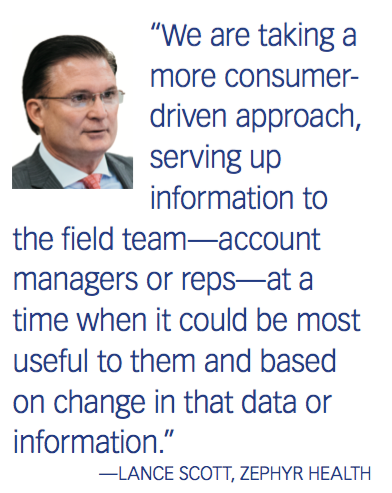
It makes their job easier because they can proactively receive information that is being pushed to them programmatically through the software and machine learning. They can then decide what to do with it or how to incorporate it. It could give them guidance in terms of key information, messaging that might be most relevant and/or prioritizing engagement with a given target or account based on something that’s changed.
MOWAD-NASSAR: What Takeda likes about Zephyr’s platform is the potential to increase pull-through and simplify the representative’s job in the very complex ecosystem that they’re operating in now.
Imagine, as you’re walking into a physician’s office, the system gives you a recommendation that’s saying, “You can provide this physician, with this information,” that takes a lot of the complexity out for the rep. You can use these insights to direct your non-personal promotion as well.
McCARTHY: The better representatives are sophisticated enough to use data to do effective problem-solving or engage the stakeholders necessary to solve a problem. Whereas others just get mired in the ambiguity of the data because it can’t be overly specific to a given patient or physician.
JAEGER: I think the biggest barrier is how to build this data infrastructure. Data is a tool, not a strategy. The way you get commercial teams to use it and not roll their eyes at it is to build data into the workflow in a way that they’re using the data but they may not even be aware that they’re using it.
PE: What else is top of mind in market access that affects reps and physicians downstream?
THORRENS: It’s important to understand the implications of payers to patient co-pay programs as there’s not a therapy that has one single payer. You generally have a smattering of payers: 30% Medicare, 40% commercial, the remaining Medicaid, for example. And some commercially insured patients may be subsidized by a State or Federal health plan that may limit their eligibility.
Also, think of all of the changes around Patient Assistance Programs, or PAPs. For these, it’s important to

consider recent advisory opinions from OIG and seek guidance to develop SOPs or program rules to best navigate their requirements. Given the nuances of these rules, PAPs are not programs that a sales rep can casually discuss with their physician customers despite their best interest for their patients’ access.
JAEGER: We are also starting to see a high level of push back on PBMs as part of the larger pricing dialog. Many different stakeholders are asking questions around how PBMs are encouraging high prices with a heavy focus on rebates. It will be interesting to see if this continues to gain traction, especially as PBMs continue to expand capabilities to include medical benefit drug management capabilities.
PE: What is happening to shift companies to a more proactive market access strategy?
JAEGER: Having a harmonized view at an organizational level around what the hypothesis is of that future market environment is critical for a consistent commercial approach. Not having this view creates inconsistency in the commercial evaluation process and diminishes efficiency. While the nature of prediction means it will never be 100% correct, an accurate and harmonized view of the future market access landscape has enhanced the commercialization process for many of my clients.
MOWAD-NASSAR: Takeda’s been moving, over the last few years, from a primary care company to a diversified company with primary care and specialty products. We recognize we need different capabilities.
For the last 18 months, we’ve been investing to win in specialty, which means building upon our hub, creating different patient services, understanding different reimbursement dynamics and helping patients understand how to get access to our medications.
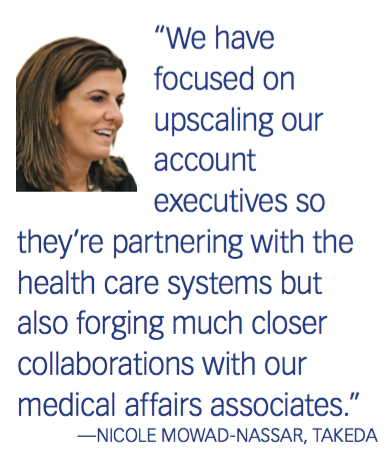
Now we’re comfortable that we’ve built those capabilities-we’ve transitioned from what’s needed in primary care to what’s needed in specialty, and focus on leading in those areas. But it is really a capability shift.
THORRENS: Looking at that primary care mold another way, reps used to call on physicians by knocking on doors. I’m oversimplifying, but for a specialty drug, where the calling point might be an urban hospital setting-trying to get access or the level of complexity associated with the decision-making processes in that hospital can be daunting. Especially when it comes to deciding the patient’s care in a post-acute care setting. Will it be the physician, the discharge planner, or case management?
MOWAD-NASSAR: We see the challenges of cost containment, cost shifting, and consolidation at all levels across the system. That’s what’s really leading to higher rebates and a more thoughtful approach to how we’re helping that patient in the cost shift.
From a policy perspective, Takeda has been trying to get involved in the conversation and make people think about medicines not as an expense but as an investment in a chronic care solution.
PE:Medicine as an investment. Doesn’t that start to get into a value, outcomes or HEOR (health economics and outcomes research) discussion?
McCARTHY: Historically, in drug development, it used to be, “Just study it enough to get it FDA-approved.” You’d look for HEOR after the fact, which is hard to do.
At Lundbeck, we’ve set up our drug development steering committee to include not just medical but commercial, HEOR, the cross-functional management team, in order to instill technology-based elements that can pick up nuances. So when you do get to the product approval, those nuances or potential benefits have been studied and can show a meaningful difference-one that has been studied from Day One, rather than in the sequential fashion of the past.
STAFF: I think that becomes a base or a core competency we all have to build. Can you show not just differentiation, but an economic improvement into the standard of care? In the future, if you’re not doing that, you’re just going to be swinging and missing constantly.
JAEGER: Providing that context around,“What is the value that it brings to the market and what can it ultimately mean from a commercial standpoint?” is absolutely imperative.
STAFF: We say, “What does the future look like three and five years out?” What do we have to be doing now to get there? Because, as we know, any kind of research, or clinical development, or paradigm shift with a payer, is going to take that long. That guides our principles on how we work together cross-functionally.
We don’t even think about how are we going to commercialize a medicine that has been submitted for approval without having a completely locked strategy with our medical affairs and health economics teams.
MOWAD-NASSAR: I think we’re getting very close to where big data analytics is going to allow us to bring payers, providers and industry together to look at a common set of data that’s very unifying around what is the patient outcome and what is the real-world evidence we can generate.
PE: Could you give one piece of advice for your colleagues in the industry on the topics we’ve discussed today?
STAFF: Never stop learning in the healthcare reimbursement space. Just when you think you’ve figured it out, you’re going to understand that there’s a lot that you don’t know. More than ever, every patient-based on their employer, their health plan, their benefit, the medicine that they’re taking, the geography they live in
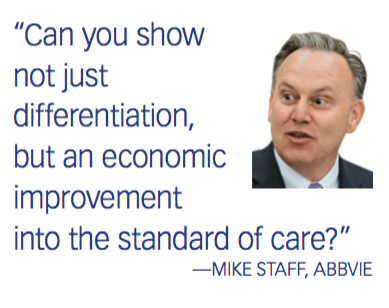
-is a unique situation.
Once you stop asking questions and trying to innovate, it’s going to pass by you so fast; it’s moving exponentially.
McCARTHY: Ensure the integration of marketing, managed markets, sales, HEOR, and medical affairs. That integration is so important because healthcare is an interdependent relationship.
THORRENS: It’s incumbent on every innovator to be able to effectively convey the value of their product in the context in which it’s reimbursed. Just because it fulfills an unmet need is not nearly enough. Understanding all of the elements around their product’s coverage by a payer, the necessary coding and setting of care implications leading to adequate payment for the healthcare provider is critical, especially in a buy-and-bill environment.
MOWAD-NASSAR: Takeda has a relatively new CEO (Christophe Weber, appointed CEO in 2015). And he said pretty simply how we’re going to refocus the business and our priorities and I think it’s true. He said, “Patient, trust, reputation, business. If you put the patient at the center of everything you do, you will build trust with society.”

The Misinformation Maze: Navigating Public Health in the Digital Age
March 11th 2025Jennifer Butler, chief commercial officer of Pleio, discusses misinformation's threat to public health, where patients are turning for trustworthy health information, the industry's pivot to peer-to-patient strategies to educate patients, and more.
Navigating Distrust: Pharma in the Age of Social Media
February 18th 2025Ian Baer, Founder and CEO of Sooth, discusses how the growing distrust in social media will impact industry marketing strategies and the relationships between pharmaceutical companies and the patients they aim to serve. He also explains dark social, how to combat misinformation, closing the trust gap, and more.